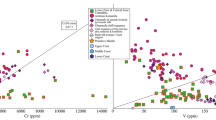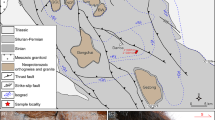Abstract
The beginning of dehydration melting in the tonalite system (biotite-plagioclase-quartz) is investigated in the pressure range of 2–12 kbar. A special method consisting of surrounding a crystal of natural plagioclase (An45) with a biotite-quartz mixture, and observing reactions at the plagioclase margin was employed for precise determination of the solidus for dehydration melting. The beginning of dehydration melting was worked out at 5 kbar for a range of compositions of biotite varying from iron-free phlogopite to iron-rich Ann70, with and without titanium, fluorine and extra aluminium in the biotite. The dehydration melting of phlogopite + plagioclase (An45) + quartz begins between 750 and 770°C at pressures of 2 and 5 kbar, at approximately 740°C at 8 kbar and between 700 and 730°C at 10 kbar. At 12 kbar, the first melts are observed at temperatures as low as 700°C. The data indicate an almost vertical dehydration melting solidus curve at low pressures which bends backward to lower temperatures at higher pressures (> 5 kbar). The new phases observed at pressures ≤ 10 kbar are melt + enstatite + clinopyroxene + potassium feldspar ± amphibole. In addition to these, zoisite was also observed at 12 kbar. With increasing temperature, phlogopite becomes enriched in aluminium and deficient in potassium. Substitution of octahedral magnesium by aluminium and titanium in the phlogopite, as well as substitution of hydroxyl by fluorine, have little effect on the beginning of dehydration melting temperatures in this system. The dehydration melting of biotite (Ann50) + plagioclase (An45) + quartz begins 50°C below that of phlogopite bearing starting composition. Solid reaction products are orthopyroxene + clinopyroxene + potassium feldspar ± amphibole. Epidote was also observed above 8 kbar, and garnet at 12 kbar (750°C). The experiments on the iron-bearing system performed at ≤ 5 kbar were buffered with NiNiO. The f O 2 in high pressure runs lies close to CoCoO. With the substitution of octahedral magnesium and iron by aluminium and titanium, and replacement of hydroxyl by fluorine in biotite, the beginning of dehydration melting temperatures in this system increase up to 780°C at 5 kbar, which is 70°C above the beginning of dehydration melting of the assemblage containing biotite (Ann50) of ideal composition. The dehydration melting at 5 kbar in the more iron-rich Ann70-bearing starting composition begins at 730°C, and in the Ann25-bearing assemblage at 710°C. This indicates that quartz-biotite-plagioclase assemblages with intermediate compositions of biotite (Ann25 and Ann50) melt at lower temperatures as compared to those containing Fe-richer or Mg-richer biotites. This study shows that the dehydration melting of tonalites may begin at considerably lower temperatures than previously thought, especially at high pressures (>5 kbar).
Similar content being viewed by others
Author information
Authors and Affiliations
Additional information
Received: 27 December 1995 / Accepted: 7 May 1996
Rights and permissions
About this article
Cite this article
Singh, J., Johannes, W. Dehydration melting of tonalites. Part I. Beginning of melting. Contrib Mineral Petrol 125, 16–25 (1996). https://doi.org/10.1007/s004100050203
Issue Date:
DOI: https://doi.org/10.1007/s004100050203




